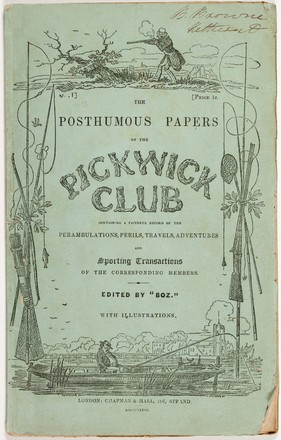The posthumous papers of the Pickwick Club
1837
Printed book
London: Chapman and Hall
Bequest of Sir William Dixson, 1952
SAFE/ 83/402–403
This is a perfect set of the first issue of Charles Dickens’ first novel, which he began at the age of 24. Each part is in its original green paper covers and contains illustrations by Hablot Knight Browne, who used the nickname ‘Phiz’.
With the subtitle ‘containing a faithful record of the perambulations, perils, travels, adventures, and sporting transactions of the corresponding members’, the novel tells a series of loosely related comic adventures about the members of a fictitious club, founded by the lead character, Samuel Pickwick. It is based on a series of captions Dickens was commissioned to write to accompany a series of illustrated ‘cockney sporting’ plates, drawn by Robert Seymour and published by Messrs Chapman and Hall.
The novel quickly became a phenomenal publishing success, and in 1838 the first pirated edition was printed by Henry Dowling of Tasmania and issued in 25 parts from August to December. During a trip to London in 1923, Sir William Dixson also purchased the Tasmanian pirate edition for £350. It is now the only known complete set in parts of the 1838 pirated edition.
As the popularity of serialised publications increased, publishers added advertisements to offset the production costs and keep the price to a low one shilling.
A lecture tour of Australia was planned for Dickens in 1862. He intended to write a travel book to be titled ‘The Uncommercial Traveller Upside Down', but the tour was cancelled.
In 1838 the first pirated edition of Pickwick Papers was printed by Henry Dowling of Tasmania. The 25 parts issued from August to December 1838 were purchased by Sir William Dixson in London in 1923 for £350. This copy, now in the State Library’s collection, is the only known complete set in parts from the 1838 pirated edition.
‘Few first novels have created as much popular excitement as The Pickwick Papers - a comic masterpiece that catapulted its twenty-four-year-old author to immediate fame. Readers were captivated by the adventures of the poet Snodgrass, the lover Tupman, the sportsman Winkle and, above all, by that quintessentially English Quixote, Mr Pickwick, and his cockney Sancho Panza, Sam Weller. From the hallowed turf of Dingley Dell Cricket Club to the unholy fracas of the Eatanswill election, via the Fleet debtors' prison, characters and incidents spring to life from Dickens's pen, to form an enduringly popular work of ebullient humour and literary invention.’*
Footnotes
* Mark Wormald, ‘Introduction’ to The Pickwick Papers by Charles Dickens, London, Penguin, 2003
‘Anythin' for a quiet life, as the man said wen he took the sitivation at the lighthouse’.* Full of witticisms, jokes and colourful characters, Charles Dickens first popular work lacks much of the social commentary included in later works like Oliver Twist and Great Expectations.
Footnotes
* C Dickens, The Posthumous Papers of the Pickwick Club, 1837, Chapter 43



 Back to list
Back to list